| Pages:
1
2
3 |
blogfast25
International Hazard
    
Posts: 10562
Registered: 3-2-2008
Location: Neverland
Member Is Offline
Mood: No Mood
|
|
Oh, I got your point alright, don't worry.
[Edited on 6-2-2015 by blogfast25]
|
|
|
DraconicAcid
International Hazard
    
Posts: 4332
Registered: 1-2-2013
Location: The tiniest college campus ever....
Member Is Offline
Mood: Semi-victorious.
|
|
Quote: Originally posted by blogfast25  |
| Quote: | | For strong bases, you need to add polyhydroxyl compounds such as Mannitol, Sorbital, Glycerol etc.. to increase the acid strength and then you can
titrate with strong bases. |
... what evidence/references do you have? |
Cotton & Wilkinson, Advanced Inorganic Chemistry, 4th Ed, p 298: In the 1:1 complexes the acidity of the OH groups exceeds that of B(OH)3, so that
if glycerol is added to a boric acid solution, this can be titrated using aqueous NaOH.
Please remember: "Filtrate" is not a verb.
Write up your lab reports the way your instructor wants them, not the way your ex-instructor wants them.
|
|
|
blogfast25
International Hazard
    
Posts: 10562
Registered: 3-2-2008
Location: Neverland
Member Is Offline
Mood: No Mood
|
|
Quote: Originally posted by DraconicAcid  | | Cotton & Wilkinson, Advanced Inorganic Chemistry, 4th Ed, p 298: In the 1:1 complexes the acidity of the OH groups exceeds that of B(OH)3, so that
if glycerol is added to a boric acid solution, this can be titrated using aqueous NaOH. |
Thanks, DA. New to me, that bit.
Simple question, simple answer, no lecture. Just like I like it.
[Edited on 6-2-2015 by blogfast25]
|
|
|
DraconicAcid
International Hazard
    
Posts: 4332
Registered: 1-2-2013
Location: The tiniest college campus ever....
Member Is Offline
Mood: Semi-victorious.
|
|
Aw, but I had almost finished typing up the lecture I was going to attach to it......
Please remember: "Filtrate" is not a verb.
Write up your lab reports the way your instructor wants them, not the way your ex-instructor wants them.
|
|
|
deltaH
Dangerous source of unreferenced speculation
    
Posts: 1663
Registered: 30-9-2013
Location: South Africa
Member Is Offline
Mood: Heavily protonated
|
|
Quote: Originally posted by Shivachemist  |
For example, Sodium metaborate is more alkaline than Borax. Its aqueous solution behaves like a mixture of borax and hydrogen peroxide. For this
reason, it is usually used as a mild oxidizing and bleaching agent. On heating, it will liberate oxygen.
[Edited on 5-2-2015 by Shivachemist] |
Are you not confusing sodium metaborate with sodium perborate?
|
|
|
Shivachemist
Harmless

Posts: 30
Registered: 1-2-2015
Member Is Offline
Mood: No Mood
|
|
Well, it was formerly considered to be a perborate, NaBO3. 4 H2O ------> NaBO2. H2O2. 3 H2O
|
|
|
deltaH
Dangerous source of unreferenced speculation
    
Posts: 1663
Registered: 30-9-2013
Location: South Africa
Member Is Offline
Mood: Heavily protonated
|
|
Do you have a reference to suggest that it's a perhydrate and the peroxide is not formally bonded to the boron?
I know that common 'sodium percarbonate' is incorrectly named and is, in fact, sodium carbonate perhydrate.
|
|
|
Shivachemist
Harmless

Posts: 30
Registered: 1-2-2015
Member Is Offline
Mood: No Mood
|
|
Well, yes, page 2.236 in the book "Textbook of Inorganic chemistry" written by PL Soni and Mohan Katyal.
This is the third time me giving references to my points. I'm really tired of this. This is ridiculous. This is more like a student is asking
references for whatever the teacher is saying just because he does not know it. If you believe me or not, it does not matter to me. I'm just giving my
suggestions and saying points that I have read. Believing it or not is up to you. Asking questions to clarify the doubts is different and asking
references for everything is different. I had worked as a moderator in a forum too for a long time and written thousands of posts and I had answered
many members questions too, at least from what I have learned heretofore. But, none has asked me references for whatever I'm saying. May be this is
your practice, I do not know. If it so, then I'm not up for this.
Thank you.
|
|
|
blogfast25
International Hazard
    
Posts: 10562
Registered: 3-2-2008
Location: Neverland
Member Is Offline
Mood: No Mood
|
|
Ah yes Sir, but do you have a license to write lectures on this forum? 
http://youtu.be/WnlIWpZSPXU
[Edited on 6-2-2015 by blogfast25]
|
|
|
Shivachemist
Harmless

Posts: 30
Registered: 1-2-2015
Member Is Offline
Mood: No Mood
|
|
oh well then, I will stop lecturing and you continue it.
|
|
|
blogfast25
International Hazard
    
Posts: 10562
Registered: 3-2-2008
Location: Neverland
Member Is Offline
Mood: No Mood
|
|
Quote: Originally posted by Shivachemist  | | This is the third time me giving references to my points. I'm really tired of this. This is ridiculous. This is more like a student is asking
references for whatever the teacher is saying just because he does not know it. If you believe me or not, it does not matter to me.
|
You really don't get it do you? Mostly it has nothing to do with 'believing you/not believing you' and only a matter of establishing where you
obtained a particular bit of wisdom from.
Having said that, give me one good reason why I should blindly believe you (or vice versa, for that matter)... because you know everything and your
knowledge base is beyond scrutiny?
[Edited on 6-2-2015 by blogfast25]
|
|
|
Shivachemist
Harmless

Posts: 30
Registered: 1-2-2015
Member Is Offline
Mood: No Mood
|
|
I never think myself brilliant and all. I have a very ordinary knowledge in chemistry. But again, I'm just saying what I know. I can ask the same
question back. Btw, did you ask your teacher references for whatever he/she is saying when you were studying? Just think. For saying this, do not
tease me by calling sir and all, me just saying for example. If you do not want me to post my opinions, I will stop writing. I have no issues with it.
Thank you.
|
|
|
deltaH
Dangerous source of unreferenced speculation
    
Posts: 1663
Registered: 30-9-2013
Location: South Africa
Member Is Offline
Mood: Heavily protonated
|
|
Quote: Originally posted by Shivachemist  | Well, yes, page 2.236 in the book "Textbook of Inorganic chemistry" written by PL Soni and Mohan Katyal.
This is the third time me giving references to my points. I'm really tired of this. This is ridiculous. This is more like a student is asking
references for whatever the teacher is saying just because he does not know it. If you believe me or not, it does not matter to me. I'm just giving my
suggestions and saying points that I have read. Believing it or not is up to you. Asking questions to clarify the doubts is different and asking
references for everything is different. I had worked as a moderator in a forum too for a long time and written thousands of posts and I had answered
many members questions too, at least from what I have learned heretofore. But, none has asked me references for whatever I'm saying. May be this is
your practice, I do not know. If it so, then I'm not up for this.
Thank you. |
The only reason is because I was giving you the benefit of the doubt. The wiki article states that it is the borate anion that carries the peroxide,
so it should formally be named perborate. Your claim that it is, in fact, a perhydrate goes contrary to the wiki article which claims the peroxide is
bonded to the boron, so simply wanted to verify which is correct.
|
|
|
blogfast25
International Hazard
    
Posts: 10562
Registered: 3-2-2008
Location: Neverland
Member Is Offline
Mood: No Mood
|
|
Quote: Originally posted by Shivachemist  | Btw, did you ask your teacher references for whatever he/she is saying when you were studying? Just think.
If you do not want me to post my opinions, I will stop writing. I have no issues with it.
|
Your first point is a silly analogy: students aren't scientists yet. They need to pass exams based on the existing curriculum. In a good education
system scepticism can be encouraged though.
Your second point is childish: no one wants you to stop posting here.
Take a step back, a deep breath and come back when you can see clearer.
[Edited on 6-2-2015 by blogfast25]
|
|
|
Chemosynthesis
International Hazard
    
Posts: 1071
Registered: 26-9-2013
Member Is Offline
Mood: No Mood
|
|
I know my opinion is uninvited, but I have enjoyed your posts thus far, shiva chemist, and would hope you wouldn't stop posting due to references. I
was unaware of both of the previous claims you made in the thread, and learned them from your posts and the subsequent references. It can be mildly
inconvenient to cite things, but I try to have citations available for any claims I make here, or in general unless otherwise qualified. Personally, I
find it very instructive as it can provide context on when literature is incorrect, or how long something has been known.
As to teachers, etc. it is commonplace for colleagues I know, myself included, to ask each other for citations on claims when conversing, particularly
regarding research, and many of these being asked are considered world-renowned experts in their fields, some with multiple doctorates. Graduate
students and post docs are encouraged to question everyone as well, and this can be a very good source of constructive criticism for grant review,
since sometimes they are less indoctrinated in the predominant groupthink.
|
|
|
Bert
Super Administrator
        
Posts: 2821
Registered: 12-3-2004
Member Is Offline
Mood: " I think we are all going to die. I think that love is an illusion. We are flawed, my darling".
|
|
Please everyone, just relax. We come from different cultures.
It's standard to give reference, if you've already done so and someone asks, just say "see further up thread", or drop a link to earlier post.
Rapopart’s Rules for critical commentary:
1. Attempt to re-express your target’s position so clearly, vividly and fairly that your target says: “Thanks, I wish I’d thought of putting it
that way.”
2. List any points of agreement (especially if they are not matters of general or widespread agreement).
3. Mention anything you have learned from your target.
4. Only then are you permitted to say so much as a word of rebuttal or criticism.
Anatol Rapoport was a Russian-born American mathematical psychologist (1911-2007).
|
|
|
blogfast25
International Hazard
    
Posts: 10562
Registered: 3-2-2008
Location: Neverland
Member Is Offline
Mood: No Mood
|
|
With all due respect but I don't see what that has to do with anything. Shivachemist (or anyone else here) is hardly representative of a culture. An
individual can't be that.
[Edited on 6-2-2015 by blogfast25]
|
|
|
quantumcorespacealchemyst
Banned Shitposter
Posts: 213
Registered: 17-10-2014
Member Is Offline
Mood: No Mood
|
|
thanks for the video Shivachemist and the flame test + other results. i am interested in this copper borate/metaborate topic.
i saw recently (http://silver.atomistry.com/silver_borate.html that reportedly) "A solution of borax reacts with one of Silver nitrate to precipitate the white
metaborate, AgBO2. It is also produced by dissolving Silver monoxide in boric acid, an equilibrium being attained. Conversely, water causes partial
hydrolysis of silver borate to Silver monoxide and boric acid.". it doesn't seem to have a source.
i find it interesting that Copper nitrate makes hydrates, and decomposes at 180°C whereas Silver nitrate can be heated and not decompose and doesn't
seem to form hydrates (does it?), but it's borate supposedly dissolves/decomposes in water, where copper borate doesn't (i believe that is the
consensus above).
|
|
|
blogfast25
International Hazard
    
Posts: 10562
Registered: 3-2-2008
Location: Neverland
Member Is Offline
Mood: No Mood
|
|
Quote: Originally posted by quantumcorespacealchemyst  | thanks for the video Shivachemist and the flame test + other results. i am interested in this copper borate/metaborate topic.
i saw recently (http://silver.atomistry.com/silver_borate.html that reportedly) "A solution of borax reacts with one of Silver nitrate to precipitate the white
metaborate, AgBO2. It is also produced by dissolving Silver monoxide in boric acid, an equilibrium being attained. Conversely, water causes partial
hydrolysis of silver borate to Silver monoxide and boric acid.". it doesn't seem to have a source.
i find it interesting that Copper nitrate makes hydrates, and decomposes at 180°C whereas Silver nitrate can be heated and not decompose and doesn't
seem to form hydrates (does it?), but it's borate supposedly dissolves/decomposes in water, where copper borate doesn't (i believe that is the
consensus above). |
Atomistry rarely provides verifiable references.
|
|
|
Abromination
Hazard to Others
  
Posts: 432
Registered: 10-7-2018
Location: Alaska
Member Is Offline
Mood: 1,4 tar
|
|
I know its been a while, but I managed to get borax and copper sulfate to react with eachother and not form something that looks like copper
hydroxide. Using an excess of copper sulfate, I added borax powder to a concentrated-ish solution of copper (ii) sulfate. I filtered the jelly like
precipitate and dried it. I rinsed off excess copper sulfate and was left with dark blue/green chuncks.
|
|
|
Lion850
National Hazard
   
Posts: 517
Registered: 7-10-2019
Location: Australia
Member Is Offline
Mood: Great
|
|
I also had a go at copper borate; specifically hoping for copper metaborate Cu(BO2)2.
First attempt:
- 15g sodium metaborate NaBO2 dissolved in 100ml water, heated until dissolved in a clear solution.
- 20g copper sulphate pentahydrate dissolved in 100ml water, heated to dissolve all.
- Slowly add the copper sulphate solution to the sodium metaborate solution (both hot). Initially there was just a slow color change but suddenly
there was a lot of gas evolution and the beaker bubbled over. The gas had no smell. This was unexpected, still don't know why it happened.
- Solution turned baby blue.
- Stir for 60 minutes and vacuum filter. Clear filtrate, baby blue remainder. Photo below. Rinse once in funnel with hot water.
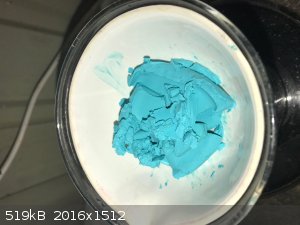
- Dry on steam bath until weight stable. Color became slightly darker. Photo below Final recovery 10g.
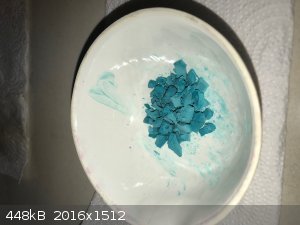
The product dissolved quite easily in concentrated HCl giving as yellow-ish solution, with tiny bit of unreacted material. I also heated some product
in a test tube on a bunsen burner for 10 minutes; it turns more green. Photo below. The green color remains when the crystals are wetted.
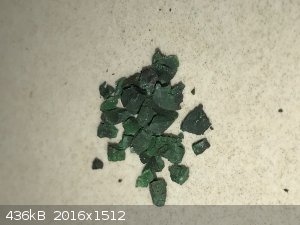
I tried to do a flame test; there is a hint of green - much less green than when I do a test with boric acid.
As mentioned a few times in this thread, what I got was probablky a mix of a copper borate and copper hydroxide?? I had another go while trying to
reduce the boric solution prior to adding the copper sulphate.
Second attampt:
- 20g copper sulphate pentahydrate in 120ml water, room temperature. Stir till all dissolved. I purposely used the same amount of CuSO4.5H2O.
- 15g sodium metaborate in 120ml water, stir to dissolve at room temperature. pH very high, 11 or more.
- Add boric acid H3BO3 to the NaBO2 solution and keep checking pH, stop after 5g added because some boric acid did not dissolve. pH around 9 as far as
I can tell from the strips.
- Mix slowly - very slowly - with both solutions at room temperature.
- Some gas evolution, for a few seconds, but much less than with the first attempt.
- Baby blue solution, similar color as first attempt.
- Stir (no heating) for 24 hour. Color remains the same, see photo below. No more unreacted boric acid to be seen.
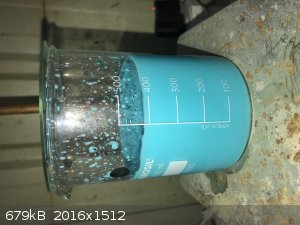
- Vacuum filter. Wash once in funnel with large volume of room temp water.
- Dry on steam bath until weight stable. See before and after photos below; dried product is much darker blue than the first attempt. Final recovery
12g.
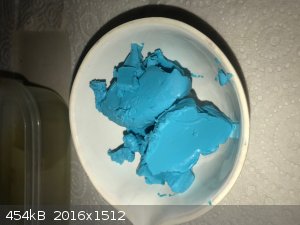
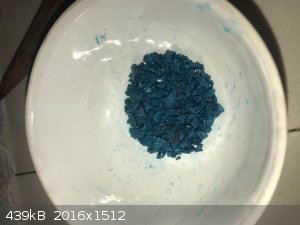
Attempt at a flame test shows very little green.
When heated on the bunsen burner, this product also turns green, photo below.
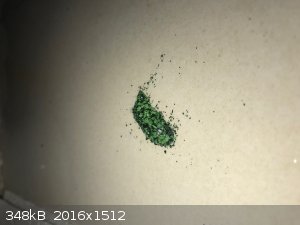
After this, I wanted to make copper hydroxide and dry it using the same steam bath to see how the final product compares to the above two. This went
as follows:
- A solution containing 20g copper sulphate pentahydrate was added to a solution of 8g sodium hydroxide when both solutions were warm - a blue
suspension formed but turned black within seconds. Looked like the copper hydroxide decomposed to copper oxide, and this was discarded.
After more reading up, the reaction was tried again but with much more dilute solutions:
- 20g CuSO4 dissolved in 400ml water
- 8g NaOH dissolved in 100ml water.
- Mix the room temperature solutions slowly, initially a light blue suspension which became a lovely dark blue. See photo. Solution was quite thick
and hard for the stir bar to get moving.
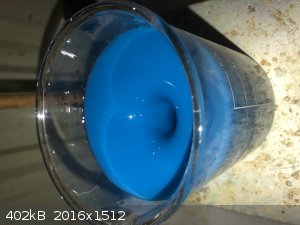
- Vacuum filter and rinse once in funnel. Clear filtrate, dark blue remainder. See photo. The remainder retained a lot more water than the "borates"
and took much longer to dry.
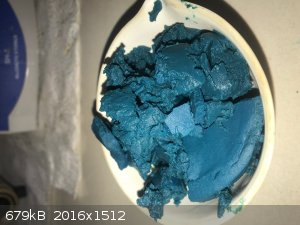
- As it dried the color changed became darker and eventually alomost black, see photo. I suspect this became a mix of hydroxide and oxide.
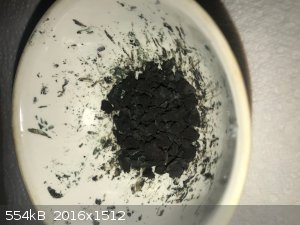
- Final recovery 9g.
- The product dissolves readily in contentrated HCl, but a bit slower than the "borates".
Thus the 'borates' are different from the hydroxide; they are much more stable in terms of keeping their color at the steam bath temperature, and seem
to retain less water i.e. they dry easier. But what I really got I dont know.
I'm tempted to have a go at stirring copper powder with boric acid and see what happens, but these kind of reactions ties up my (only) stirring
hotplate for days. So it will have to wait as something else is currently on the plate.
Photo for comparison:
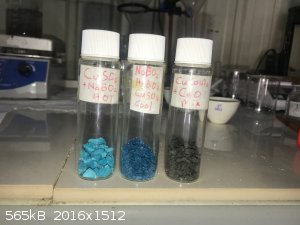
|
|
|
Bedlasky
International Hazard
    
Posts: 1239
Registered: 15-4-2019
Location: Period 5, group 6
Member Is Offline
Mood: Volatile
|
|
I think that blue precipitate is some polyborate (like di-, tri-, tetraborate etc.) and the green stuff if actually metaborate. You can see some other
black material in your green solid - this is probably CuO.
|
|
|
unionised
International Hazard
    
Posts: 5126
Registered: 1-11-2003
Location: UK
Member Is Offline
Mood: No Mood
|
|
one of the earlier references in this thread
https://books.google.co.uk/books?id=MGQ9AAAAYAAJ&pg=PA66...
says that copper borate melts easily .
Copper (hydr)oxide won't melt easily.
Are you able to check if your product forms a dark red glassy material when melted + cooled?
[Edited on 2-9-20 by unionised]
|
|
|
Lion850
National Hazard
   
Posts: 517
Registered: 7-10-2019
Location: Australia
Member Is Offline
Mood: Great
|
|
Gents thanks for the replies. I was aware of that report of copper borate melting 'easily' but when I heated my 2 products in a strong bunsen burner
flame they only turned green.
Clear info on what happens to copper borates when heated seems not that easy to find online. The attached document describes synthesis of copper
borates and has a section on their thermal decomposition:
"The temperature of the thermal decomposition process of copper hydroxyl nitrate was reported to be 246 °C [9]
which was very close to those of the precipitates obtained in the present study. The mass loss onset temperatures of the all samples were between
237.7 and 248.7 °C as shown in Table S1. The remaining mass after thermal decomposition would be 66% considering the stoichiometry of the reaction in
Eq. 2. The remained mass from the samples at 600 °C were in the range of 63.4% and 70.9% as indicated in Table S1."
It does not mention melting, rather decomposition as far as I can make out.
Attachment: Prep of copper borates as lubricant additives.pdf (537kB)
This file has been downloaded 378 times
|
|
|
old school
Harmless

Posts: 2
Registered: 27-9-2020
Member Is Offline
|
|
Attempt at prep. of copper borate
Forgive me for not posting exact weighed measurements, but I added about 2 tablespoons of copper sulphate "feed grade" crystals in about 250 ml of
distilled H2O in one flask, and then ~ 2 tablespoons of laundry borax in ~250 ml of distilled H2O in another flask, warmed both both flasks for ~1
minute in microwave, stirred well. Then dumped the contents of the copper sulphate flask into the borax flask, stirred by hand another minute or two.
Next, poured it all into a teflon beaker and placed on a magnetic stirrer hot plate stirring vigorously, ran the temp. up to 62C, kept it for 2 hours.
Used a simple coffee filter to filter out the precipitate, washed the cuprous borate out several times with distilled H2O over an hour, it drained
very, very slowly - - a vaccum filtration would have been better. Finally, placed the turquoise filter cake on a teflon mat in the oven drying it at
~93C for 2 hours. Disposed of the Na2So4 filtrate.
If there was any CuOH2 in the final product it would have been revealed by the rather classic lab procedure of heating a small portion of my final
product in distilled H2O at ~97C, just below boiling for an hour which converts any CuOH2 present to black CuO, with a few boiling
stones for good measure. I did that.
Result: No black color was observed at all.
From the patent literature:
For example, 763 parts of water solution containing 10 percent decahydrated borax Na₂B₄O₇ · 10 H₂O were added, under stirring, to 125 parts
of water solution containing 40 percent pentahydrated copper sulphate CuSO₄· 5H₂O at 50 oC. The solution was kept at 50 oC for 1 hour, and then
kept at 20 - 30 oC for one night, consequently resulting in a precipitation. The precipitation was filtered and washed with water repeatedly until
unreacted borax was completely removed, and dried at 40 ° C. Consequently, 26.81 grams of copper tetraborate,dibasic were obtained.
3. COPPER TETRABORATE TRIBASIC--3Cu(OH)₂·CuB₄O₇--
[0027]
Copper tetraborate,tribasic is prepared by mixing a solution containing a high concentration of copper sulphate and a solution containing a high
concentration of borax at a remarkably high temperature, e.g., 60 oC with adding a greater amount of water with maintaining a ratio of one mole copper
sulphate to one mole borax. Specifically, after copper tetraborate is produced as shown in FORMULA (1), water washing is executed repeatedly to
produce copper tetraborate,tribasic as shown in FORMULA (4).
Figure imgb0003
[0028]
For example, 12.5 parts of water solution containing 40 percent pentahydrated copper sulphate CuSO4· 5H2O - - - - - and - - - -
75 parts of water solution containing 10.2 percent decahydrated borax Na₂B₄O₇ · 10 H2O were mixed with maintaining the ratio of 1 to 6, i.e.,
the ratio of one mole to one mole, at 60 ° C.
100 parts of water were added into the solution at 60 °C, and was kept at 60 °C for 1 hour, and then kept at 20 - 30°C for one night, consequently
resulting in a precipitation. The precipitate was filtered and washed with water repeatedly until unreacted borax was completely removed, and dried at
60° for 48 hours. Consequently, 2.43 grams of copper tetraborate, tribasic were obtained.
https://patents.google.com/patent/EP0450568A2/en
|
|
|
| Pages:
1
2
3 |